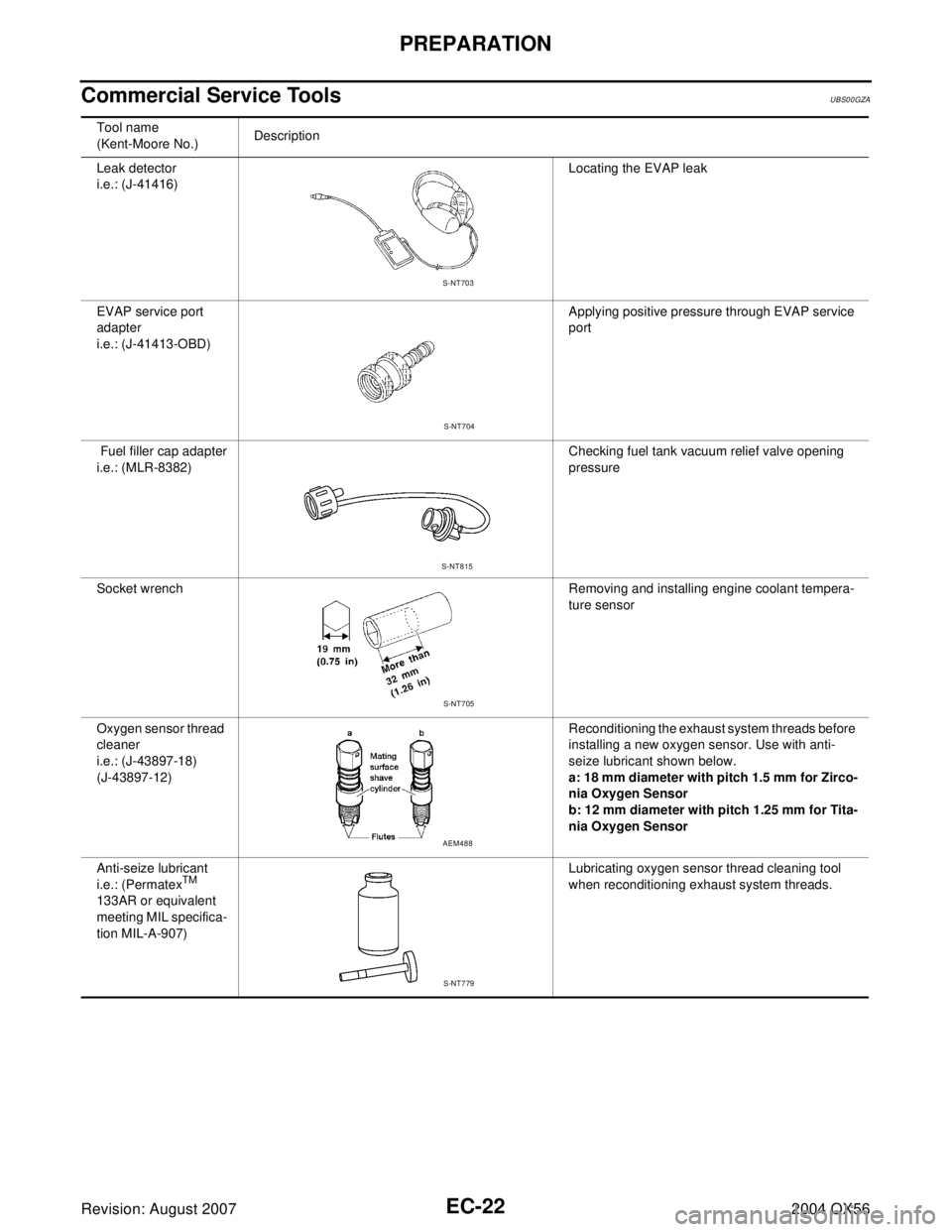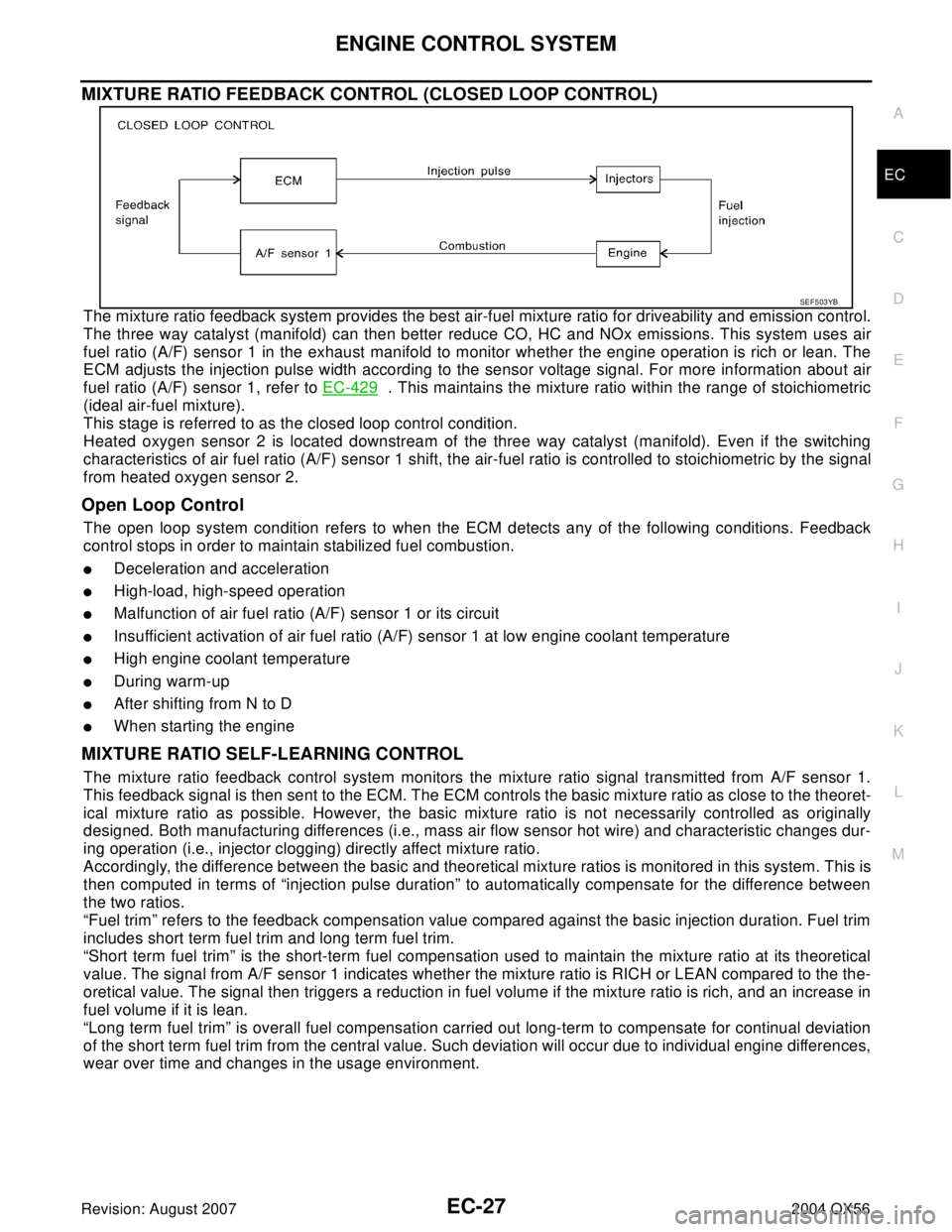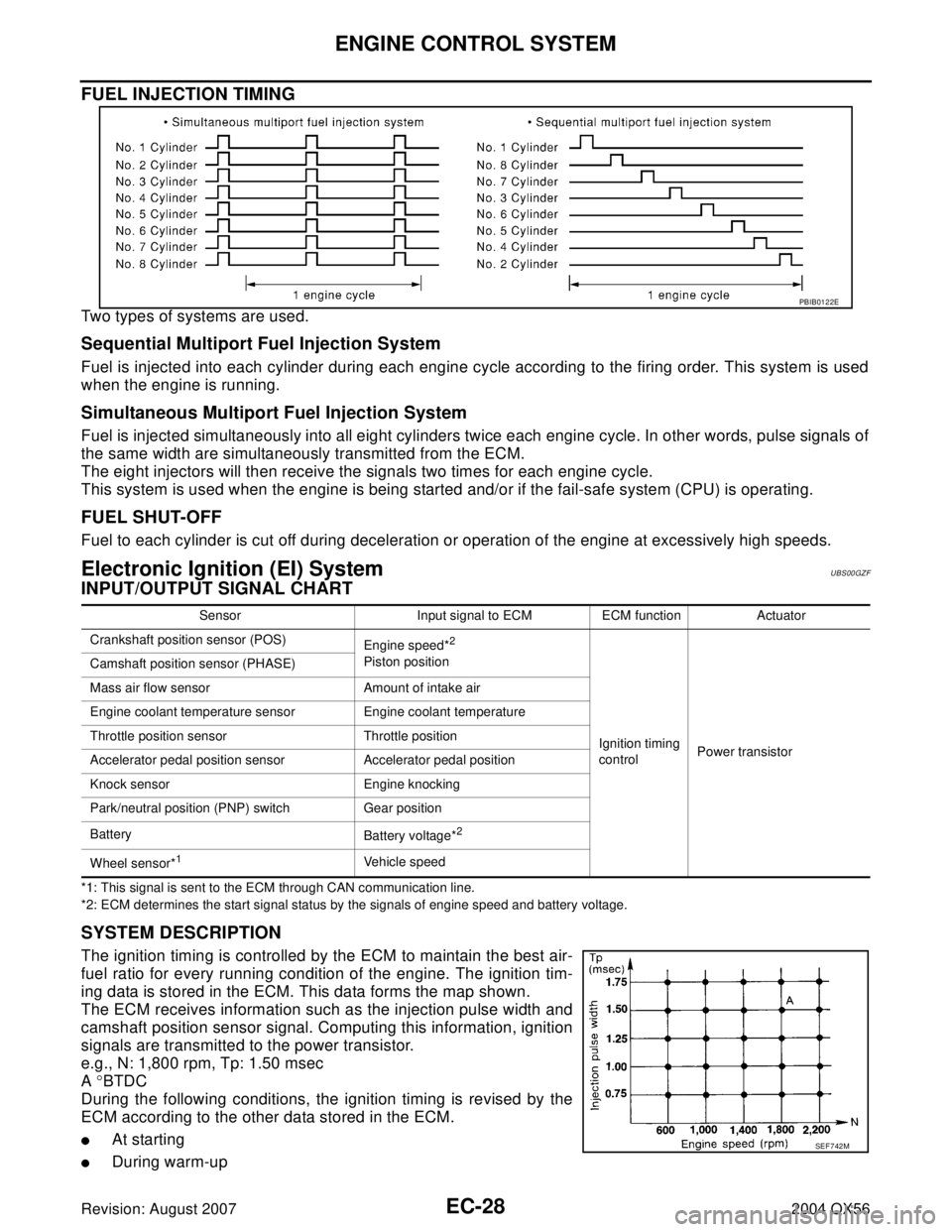Page 1212 of 3371
PREPARATION
EC-21
C
D
E
F
G
H
I
J
K
L
MA
EC
Revision: August 20072004 QX56
KV109E0010
(J-46209)
Break-out boxMeasuring the ECM signals with a circuit tester
KV109E0080
(J-45819)
Y-cable adapterMeasuring the ECM signals with a circuit tester
(J-23688)
Engine coolant refrac-
tometerChecking concentration of ethylene glycol in en-
gine coolant Tool number
(Kent-Moore No.)
Tool nameDescription
S-NT825
S-NT826
W BIA0539E
Page 1213 of 3371

EC-22Revision: August 2007
PREPARATION
2004 QX56
Commercial Service ToolsUBS00GZA
Tool name
(Kent-Moore No.)Description
Leak detector
i.e.: (J-41416)Locating the EVAP leak
EVAP service port
adapter
i.e.: (J-41413-OBD)Applying positive pressure through EVAP service
port
Fuel filler cap adapter
i.e.: (MLR-8382)Checking fuel tank vacuum relief valve opening
pressure
Socket wrench Removing and installing engine coolant tempera-
ture sensor
Oxygen sensor thread
cleaner
i.e.: (J-43897-18)
(J-43897-12)Reconditioning the exhaust system threads before
installing a new oxygen sensor. Use with anti-
seize lubricant shown below.
a: 18 mm diameter with pitch 1.5 mm for Zirco-
nia Oxygen Sensor
b: 12 mm diameter with pitch 1.25 mm for Tita-
nia Oxygen Sensor
Anti-seize lubricant
i.e.: (Permatex
TM
133AR or equivalent
meeting MIL specifica-
tion MIL-A-907)Lubricating oxygen sensor thread cleaning tool
when reconditioning exhaust system threads.
S-NT703
S-NT704
S-NT815
S-NT705
AEM488
S-NT779
Page 1214 of 3371
ENGINE CONTROL SYSTEM
EC-23
C
D
E
F
G
H
I
J
K
L
MA
EC
Revision: August 20072004 QX56
ENGINE CONTROL SYSTEMPFP:23710
System DiagramUBS00GZB
PBIB2051E
Page 1215 of 3371
EC-24Revision: August 2007
ENGINE CONTROL SYSTEM
2004 QX56
Vacuum Hose DrawingUBS00GZC
Refer to EC-23, "System Diagram" for Vacuum Control System.
PBIB2052E
Page 1216 of 3371

ENGINE CONTROL SYSTEM
EC-25
C
D
E
F
G
H
I
J
K
L
MA
EC
Revision: August 20072004 QX56
System ChartUBS00GZD
*1: This sensor is not used to control the engine system. This is used only for the on board diagnosis.
*2: This sensor is not used to control the engine system under normal conditions.
*3: This input signal is sent to the ECM through CAN communication line.
*4: This output signal is sent from the ECM through CAN communication line.Input (Sensor) ECM Function Output (Actuator)
�Camshaft position sensor (PHASE)
�Crankshaft position sensor (POS)
�Mass air flow sensor
�Engine coolant temperature sensor
�A/F sensor 1
�Throttle position sensor
�Accelerator pedal position sensor
�Park/neutral position (PNP) switch
�Intake air temperature sensor
�Power steering pressure sensor
�Ignition switch
�Battery voltage
�Knock sensor
�Refrigerant pressure sensor
�Stop lamp switch
�ASCD steering switch
�ASCD brake switch
�Fuel level sensor*1 *3
�EVAP control system pressure sensor
�Fuel tank temperature sensor*1
�Heated oxygen sensor 2*2
�TCM (Transmission control module)*3
�ABS actuator and electric unit (control unit)*3
�Air conditioner switch*3
�Wheel sensor*3
�Electrical load signal*3
Fuel injection & mixture ratio control Fuel injector
Electronic ignition system Power transistor
Nissan torque demand control system
�Electric throttle control actuator
�Fuel injector
Fuel pump control Fuel pump relay
ASCD vehicle speed control Electric throttle control actuator
On board diagnostic system
MIL (On the instrument panel)*
4
A/F sensor 1 heater control A/F sensor 1 heater
Heated oxygen sensor 2 heater control Heated oxygen sensor 2 heater
EVAP canister purge flow controlEVAP canister purge volume control
solenoid valve
Air conditioning cut control
Air conditioner relay*
4
Cooling fan control
Cooling fan relay*4
ON BOARD DIAGNOSIS for EVAP system EVAP canister vent control valve
Page 1217 of 3371

EC-26Revision: August 2007
ENGINE CONTROL SYSTEM
2004 QX56
Multiport Fuel Injection (MFI) SystemUBS00GZE
INPUT/OUTPUT SIGNAL CHART
*1: This sensor is not used to control the engine system under normal conditions.
*2: This signal is sent to the ECM through CAN communication line.
*3: ECM determines the start signal status by the signals of engine speed and battery voltage.
SYSTEM DESCRIPTION
The amount of fuel injected from the fuel injector is determined by the ECM. The ECM controls the length of
time the valve remains open (injection pulse duration). The amount of fuel injected is a program value in the
ECM memory. The program value is preset by engine operating conditions. These conditions are determined
by input signals (for engine speed and intake air) from both the crankshaft position sensor (POS), camshaft
position sensor (PHASE) and the mass air flow sensor.
VARIOUS FUEL INJECTION INCREASE/DECREASE COMPENSATION
In addition, the amount of fuel injected is compensated to improve engine performance under various operat-
ing conditions as listed below.
�During warm-up
�When starting the engine
�During acceleration
�Hot-engine operation
�When selector lever is changed from N to D
�High-load, high-speed operation
�During deceleration
�During high engine speed operation
Sensor Input signal to ECM ECM function Actuator
Crankshaft position sensor (POS)
Engine speed*
3
Piston position
Fuel injection
& mixture ratio
controlFuel injector Camshaft position sensor (PHASE)
Mass air flow sensor Amount of intake air
Engine coolant temperature sensor Engine coolant temperature
A/F sensor 1 Density of oxygen in exhaust gas
Throttle position sensor Throttle position
Accelerator pedal position sensor Accelerator pedal position
Park/neutral position (PNP) switch Gear position
Knock sensor Engine knocking condition
Battery
Battery voltage*
3
Power steering pressure sensor Power steering operation
Heated oxygen sensor 2*
1Density of oxygen in exhaust gas
ABS actuator and electric unit (control unit)*
2VDC/TCS operation command
Air conditioner switch*
2Air conditioner operation
Wheel sensor*
2Vehicle speed
Page 1218 of 3371

ENGINE CONTROL SYSTEM
EC-27
C
D
E
F
G
H
I
J
K
L
MA
EC
Revision: August 20072004 QX56
MIXTURE RATIO FEEDBACK CONTROL (CLOSED LOOP CONTROL)
The mixture ratio feedback system provides the best air-fuel mixture ratio for driveability and emission control.
The three way catalyst (manifold) can then better reduce CO, HC and NOx emissions. This system uses air
fuel ratio (A/F) sensor 1 in the exhaust manifold to monitor whether the engine operation is rich or lean. The
ECM adjusts the injection pulse width according to the sensor voltage signal. For more information about air
fuel ratio (A/F) sensor 1, refer to EC-429
. This maintains the mixture ratio within the range of stoichiometric
(ideal air-fuel mixture).
This stage is referred to as the closed loop control condition.
Heated oxygen sensor 2 is located downstream of the three way catalyst (manifold). Even if the switching
characteristics of air fuel ratio (A/F) sensor 1 shift, the air-fuel ratio is controlled to stoichiometric by the signal
from heated oxygen sensor 2.
Open Loop Control
The open loop system condition refers to when the ECM detects any of the following conditions. Feedback
control stops in order to maintain stabilized fuel combustion.
�Deceleration and acceleration
�High-load, high-speed operation
�Malfunction of air fuel ratio (A/F) sensor 1 or its circuit
�Insufficient activation of air fuel ratio (A/F) sensor 1 at low engine coolant temperature
�High engine coolant temperature
�During warm-up
�After shifting from N to D
�When starting the engine
MIXTURE RATIO SELF-LEARNING CONTROL
The mixture ratio feedback control system monitors the mixture ratio signal transmitted from A/F sensor 1.
This feedback signal is then sent to the ECM. The ECM controls the basic mixture ratio as close to the theoret-
ical mixture ratio as possible. However, the basic mixture ratio is not necessarily controlled as originally
designed. Both manufacturing differences (i.e., mass air flow sensor hot wire) and characteristic changes dur-
ing operation (i.e., injector clogging) directly affect mixture ratio.
Accordingly, the difference between the basic and theoretical mixture ratios is monitored in this system. This is
then computed in terms of “injection pulse duration” to automatically compensate for the difference between
the two ratios.
“Fuel trim” refers to the feedback compensation value compared against the basic injection duration. Fuel trim
includes short term fuel trim and long term fuel trim.
“Short term fuel trim” is the short-term fuel compensation used to maintain the mixture ratio at its theoretical
value. The signal from A/F sensor 1 indicates whether the mixture ratio is RICH or LEAN compared to the the-
oretical value. The signal then triggers a reduction in fuel volume if the mixture ratio is rich, and an increase in
fuel volume if it is lean.
“Long term fuel trim” is overall fuel compensation carried out long-term to compensate for continual deviation
of the short term fuel trim from the central value. Such deviation will occur due to individual engine differences,
wear over time and changes in the usage environment.
SEF 5 03 YB
Page 1219 of 3371

EC-28Revision: August 2007
ENGINE CONTROL SYSTEM
2004 QX56
FUEL INJECTION TIMING
Two types of systems are used.
Sequential Multiport Fuel Injection System
Fuel is injected into each cylinder during each engine cycle according to the firing order. This system is used
when the engine is running.
Simultaneous Multiport Fuel Injection System
Fuel is injected simultaneously into all eight cylinders twice each engine cycle. In other words, pulse signals of
the same width are simultaneously transmitted from the ECM.
The eight injectors will then receive the signals two times for each engine cycle.
This system is used when the engine is being started and/or if the fail-safe system (CPU) is operating.
FUEL SHUT-OFF
Fuel to each cylinder is cut off during deceleration or operation of the engine at excessively high speeds.
Electronic Ignition (EI) SystemUBS00GZF
INPUT/OUTPUT SIGNAL CHART
*1: This signal is sent to the ECM through CAN communication line.
*2: ECM determines the start signal status by the signals of engine speed and battery voltage.
SYSTEM DESCRIPTION
The ignition timing is controlled by the ECM to maintain the best air-
fuel ratio for every running condition of the engine. The ignition tim-
ing data is stored in the ECM. This data forms the map shown.
The ECM receives information such as the injection pulse width and
camshaft position sensor signal. Computing this information, ignition
signals are transmitted to the power transistor.
e.g., N: 1,800 rpm, Tp: 1.50 msec
A °BTDC
During the following conditions, the ignition timing is revised by the
ECM according to the other data stored in the ECM.
�At starting
�During warm-up
PBIB0122E
Sensor Input signal to ECM ECM function Actuator
Crankshaft position sensor (POS)
Engine speed*
2
Piston position
Ignition timing
controlPower transistor Camshaft position sensor (PHASE)
Mass air flow sensor Amount of intake air
Engine coolant temperature sensor Engine coolant temperature
Throttle position sensor Throttle position
Accelerator pedal position sensor Accelerator pedal position
Knock sensor Engine knocking
Park/neutral position (PNP) switch Gear position
Battery
Battery voltage*
2
Wheel sensor*1Vehicle speed
SEF 7 42 M